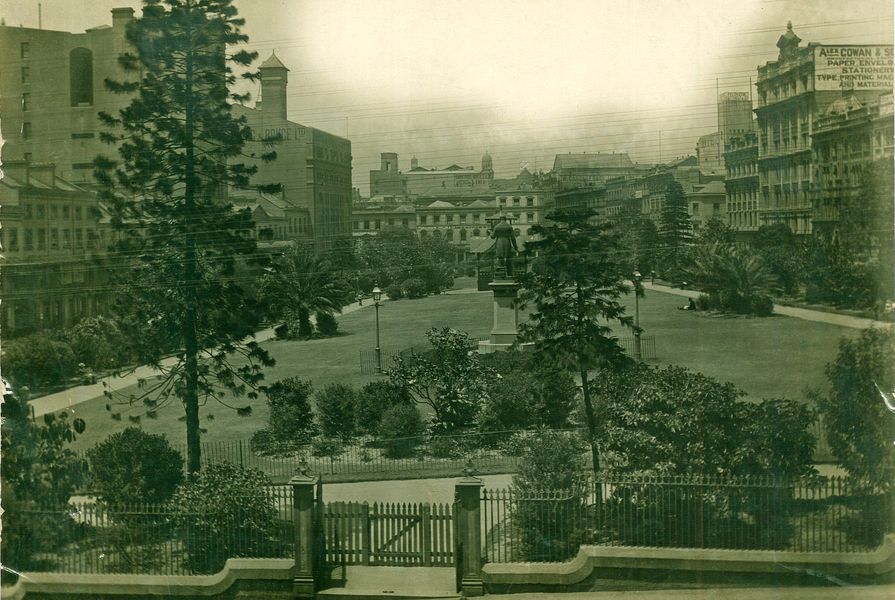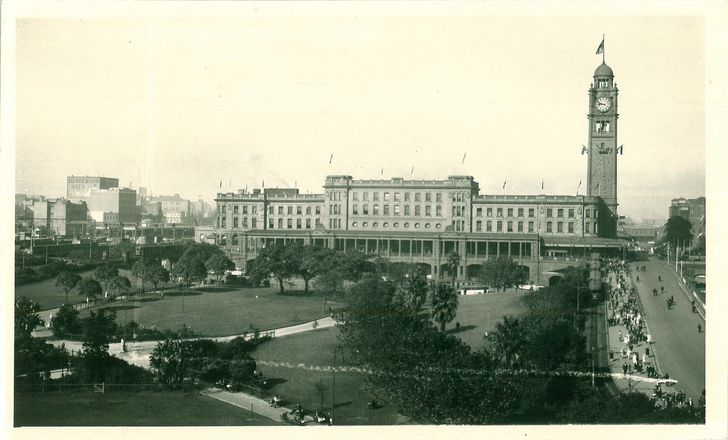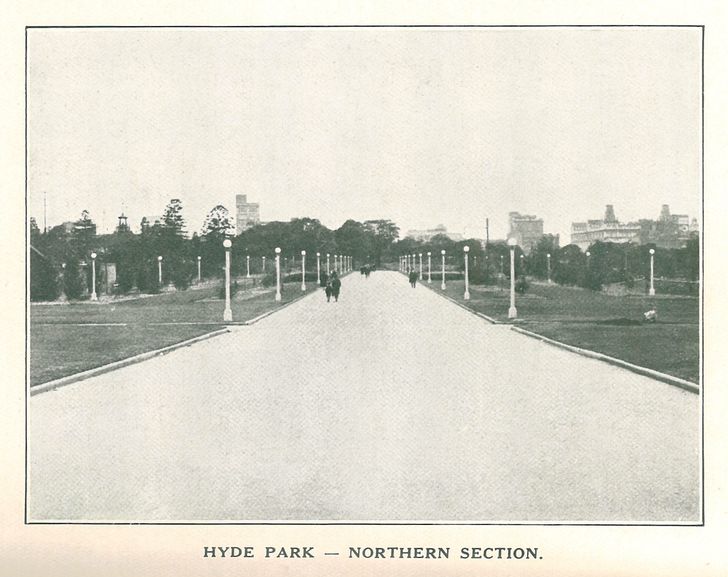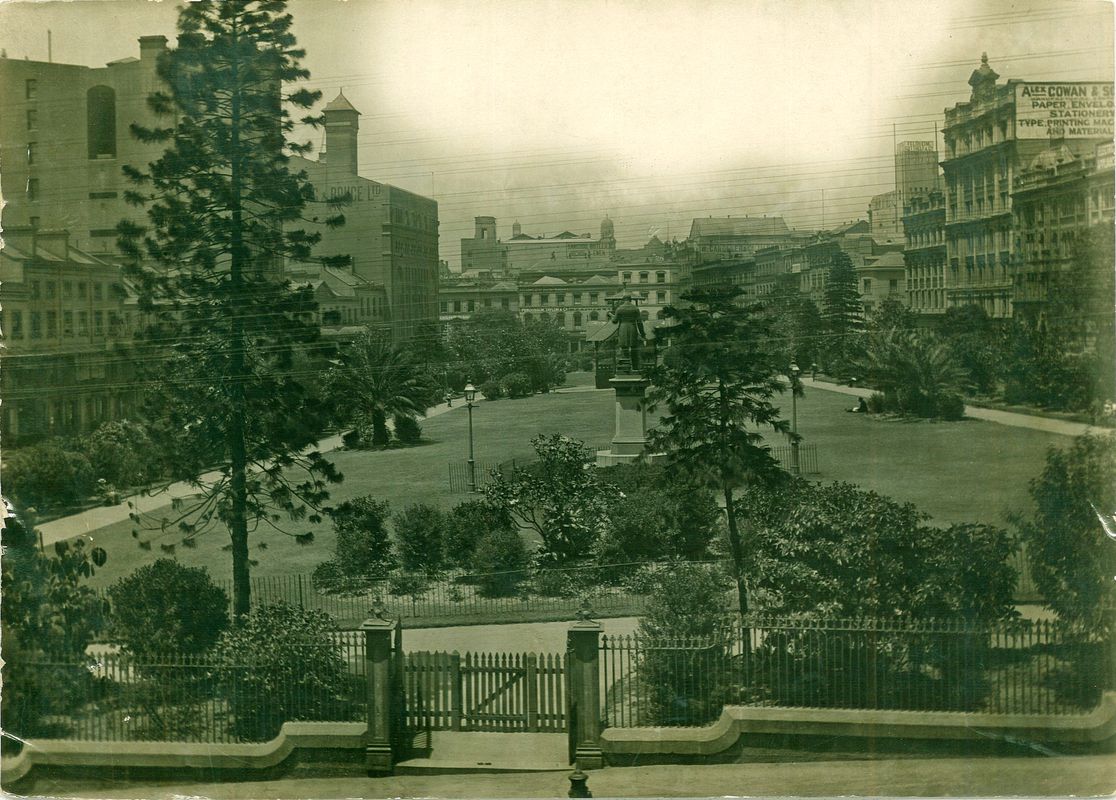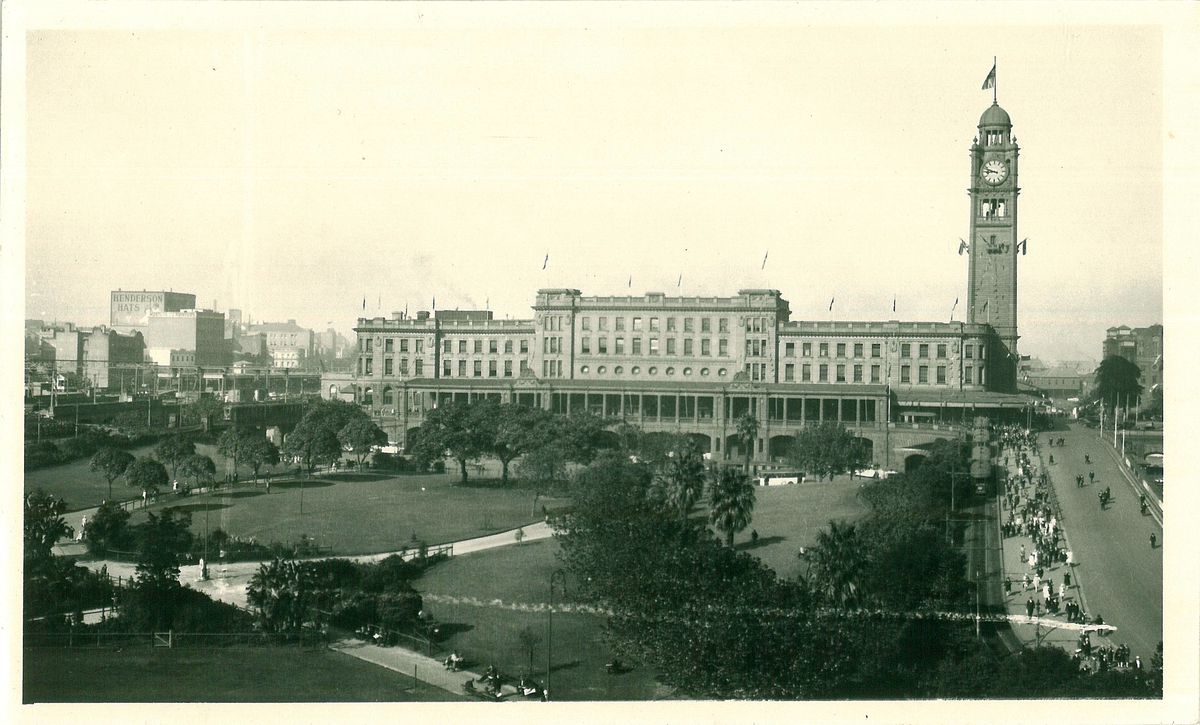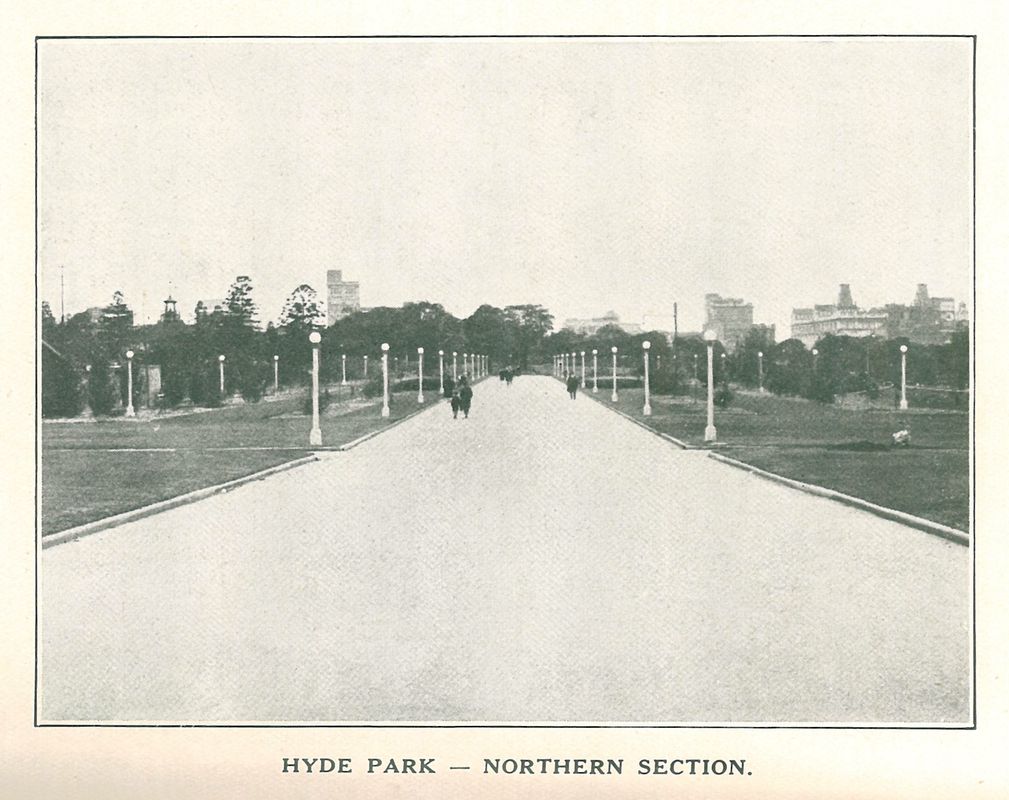The settlement of Sydney was 22 years old when its first recreation ground was proclaimed in 1810, in an area hitherto called ‘The Common’, ‘Exercising Ground‘, ‘Cricket Ground’ or ‘Racecourse’. Governor Lachlan Macquarie named it Hyde Park after the one in central London, and it is still one of Sydney’s premier parks.
The next major open space reserved in Sydney was the Botanical Garden (now Royal Botanic Gardens) established in 1816. The Gardens have always had a dual role as a botanical and scientific institution as well as a place of public recreation. The first Colonial Botanist was Charles Frazer (or Fraser), a private in the 56th Regiment who arrived in Sydney in 1816 and was soon relieved of his military duties and set to plant collecting and cultivation.
Belmore Park and Central Railway in 1926 after the construction of the new city circle rail line.
Image: City of Sydney Archives, 030773
Centennial Park’s origins
Having declared the original common a park, Governor Macquarie dedicated a second common of 1000 acres in 1811. The land was a mixture of sandhills and swamps, and took in all the area of modern Centennial Park and Moore Park, including the entertainment precinct and adjacent sports grounds.
By the 1860s the rise of organised public recreation created a demand for more public space. In 1866 Sydney Common was gazetted as a public park under the control of Sydney Municipal Council, and the following year work began on levelling the sand dunes and planting stabilising vegetation. At the same time the area was renamed Moore Park to honour Charles Moore, who served as Lord Mayor of Sydney from 1867 to 1869. Over the next 30 years major facilities were built there: Sydney Cricket Ground in the 1870s, the Showground and Zoological Gardens in the 1880s, and the Sports Ground in the 1900s.
In the 1870s pressure grew from urban reformers and suburban residents for the government to provide parks and recreation areas. This new attitude was reflected in Sir Henry Parkes’s Land for Public Purposes Acquisition Act of 1880, which allocated £200,000 to buy land for local parks across the state. Such was the demand that the whole amount was spent within two years, but over the next decade large tracts of new land were created by reclamation at Rushcutters Bay, Blackwattle Bay and Rozelle Bay. In addition new municipalities such as Alexandria, Erskineville, Redfern and Waterloo created their own parks, often on land which had been rejected for private development due to its marshy or sandy soil.
The influence of the Directors of the Sydney Botanic Gardens on the layout, form and content of parks was extensive throughout the 19th and early 20th centuries. A second Charles Moore (not the Lord Mayor) was Director from 1848 to 1896. He advised custodians of parks throughout Sydney and was responsible for the perimeter plantings of native figs which still dominate many of Sydney’s parks. His successor Joseph Maiden (Director 1896–1924) advocated the use of palms to emphasise Sydney’s subtropical climate, and his plantings are still evident in Macquarie Street, Centennial Park and in suburbs such as Randwick, Balmain and Haberfield.
Hyde Park North after completion of the underground railway, 1930.
Image: City of Sydney Archives, NSCA CRS 43 (1930) Vade Mecum, p182
20th century developments
The early years of the 20th century saw a turning point in attitudes to parks. Maiden wrote an article on ‘The parks of Sydney’ in 1902 which he followed up in other forums such as the 1909 Royal Commission on the Improvement of Sydney and Suburbs. His research revealed that while the metropolitan area overall might have adequate open space, the most heavily populated suburbs such as Darlington and Newtown had virtually none.
Simultaneously the rise of town planning emphasised the need for statutory provision of parkland and green belts. Public parks and open spaces contributed not just to the beauty of the city, but to the health of its inhabitants. Sir John Sulman’s 1890 lecture ‘The laying out of towns’ marked the beginning of town planning in Australia, and he was an influential advocate for open space and garden suburbs over the next 40 years. Pressure by men such as Maiden and Sulman coincided with the Sydney City Council taking over control of Hyde, Cook and Phillip Parks in 1905 and establishing its City Parks Branch.
Adopting its new responsibility with gusto, Council donated £300 to the NSW Band Association for playing 60 performances in city parks during summer evenings. In Hyde Park and Prince Alfred Park attendances were estimated at 8000 to 10,000 and the Town Clerk described the program as an example of ‘higher municipalism’. The introduction of electric lighting after 1906 meant that parks could be lit at night, improving access and safety. In the first decade of the 20th century, following the trend in the USA, railing fences around parks were also removed to emphasise the fact that the parks were public, rather than private, property.
Public support for the parks
Inevitably the provision of public parks continued to fall behind the demands of activists such as the Parks Preservation Society (founded in 1914). Its successor, the Parks and Playgrounds Movement, was founded in 1930 and two years later published the Basic Report, which declared that ten per cent of a city’s area should be devoted to recreational space, then determined that most suburbs in Sydney fell far short. The Parks and Playground Movement was heavily influenced by social Darwinism, and declared that ‘clean sport is not merely preventive of crime; it is undoubtedly one of the most powerful positive character-moulding influences in operation in the world today’.
The inadequate provision of parks in Sydney was admitted by City Engineer Arnold Garnsey in 1948, when he stated that ‘In our own City of Sydney most of its present parks and open spaces such as Hyde Park, Moore Park, the Domain, which constitute 80 per cent of the park system, were left as open spaces prior to the year 1878, and during the last 50 years only 12 acres have been added to the park system of which 9 acres being residues from resumptions in connection with the Harbour Bridge’.
After World War II a major report on the city’s parks was prepared by Mr Garnsey and Alderman Ernest Marks, Vice-Chairman of the Health and Recreations committee. Their report to the Council in 1946 recommended a program of increasing and improving the city’s parks, open spaces, children’s playgrounds and street tree planting. Admitting that ‘the scheme now submitted appears ambitious and of a magnitude beyond the financial resources of the Council’, they nevertheless urged its adoption as a ‘Master Plan to prevent haphazard development and with a consummation period of 30 years’. The report was adopted and led to the creation of Council’s first Department of Parks and Recreations in 1948.
1948 also saw the expansion of the City Council’s boundaries to take in the former municipalities of Alexandria, Darlington, Erskineville, Glebe, Newtown, Paddington, Redfern and Waterloo, the very areas which had the lowest open space and highest population density. Although the Marks-Garnsey report proposed large-scale parks in areas with little open space, few of these plans came to fruition. More typical of the period were ‘pocket parks’ occupying one or two terrace house sites which were acquired by resumption. During the 1950s and 1960s aldermen of the enlarged city scoured their wards for vacant sites which could be turned into new parks.
New parks today
Despite urban consolidation and population growth, the late 20th and early 21st centuries saw the creation of a number of significant new parks in the inner city. The largest at 40 hectares was Sydney Park on a former brickworks and rubbish tip site in Alexandria. Redevelopment created green spaces such as Jessie Street Gardens at Circular Quay, Harmony Park in Surry Hills, Edmund Resch Park in Redfern and Joynton Park in Zetland. Rehabilitation of former industrial harbourside land brought about Pyrmont Point Park and Glebe Foreshore Parklands. The colonnaded former Paddington Reservoir was turned into an underground park, which won the Australian Award for Urban Design in 2009.
Craig Burton (1993) ‘A history of urban parks in New South Wales’, in Elizabeth Close and David Beaver (eds) Urban parks of heritage significance, National Trust, Sydney, pp 11–16.
City of Sydney parks histories, http://www.cityofsydney.nsw.gov.au/learn/sydneys-history/people-and-places/park-histories.
Chris Cunneen (1980) ‘”Hands off the Parks!” The provision of parks and playgrounds’, in Jill Roe (ed) Twentieth century Sydney: studies in urban and social history, Hale and Iremonger, Sydney, pp 105–19.
Robert Freestone (2001) ‘Imagineering the City Beautiful: parks, gardens, and town planning thought’, in Georgina Whitehead (ed) Planting the nation, Australian Garden History Society, Melbourne, pp 159–86.
Georgina Whitehead (2002) ‘Public parks and gardens’, in Richard Aitken and Michael Looker (eds) The Oxford Companion to Australian Gardens, Oxford University Press, Melbourne, pp 490–93.
This article was originally published in Australian Garden History, volume 28 no 1, July 2016.

